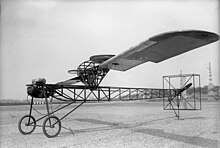 |
| Flywheel from stationary engine. Note the castellated rim which was used to rotate the engine to the correct starting position by means of a lever |
A flywheel is a mechanical device with a significant moment of inertia used as a storage device for rotational energy. Flywheels resist changes in their rotational speed, which helps steady the rotation of the shaft when a fluctuating torque is exerted on it by its power source such as a piston-based (reciprocating) engine, or when an intermittent load, such as a piston pump, is placed on it.
Flywheels can be used to produce very high power pulses for experiments, where drawing the power from the public network would produce unacceptable spikes. A small motor can accelerate the flywheel between the pulses.
Recently, flywheels have become the subject of extensive research as power storage devices for uses in vehicles and power plants.
History
 |
| 1898 illustration of a White and Middleton stationary engine; note the large twin flywheels |
The principle of the flywheel is found in the Neolithic spindle and the potter's wheel.
The Andalusian agronomist Ibn Bassal (fl 1038–1075), in his Kitab al-Filaha, describes the flywheel effect employed in a water wheel machine, the saqiya.
The flywheel as a general mechanical device for equalizing the speed of rotation is, according to the American medievalist Lynn White, recorded in the De diversibus artibus (On various arts) of the German artisan Theophilus Presbyter (ca. 1070–1125) who records applying the device in several of his machines.
In the Industrial Revolution, James Watt contributed to the development of the flywheel in the steam engine, and his contemporary James Pickard used a flywheel combined with a crank to transform reciprocating into rotary motion.
Physics
A flywheel is a spinning wheel or disc with a fixed axle so that rotation is only about one axis. Energy is stored in the rotor as kinetic energy, or more specifically, rotational energy:
Where:
ω is the angular velocity, and
I is the moment of inertia of the mass about the center of rotation. The moment of inertia is the measure of resistance to torque applied on a spinning object (i.e. the higher the moment of inertia, the slower it will spin after being applied a given force).
The moment of inertia for a solid-cylinder is ,
for a thin-walled empty cylinder is ,
and for a thick-walled empty cylinder is ,
Where m denotes mass, and r denotes a radius.
When calculating with SI units, the standards would be for mass, kilograms; for radius, meters; and for angular velocity, radians per second. The resulting answer would be in joules.
The amount of energy that can safely be stored in the rotor depends on the point at which the rotor will warp or shatter. The hoop stress on the rotor is a major consideration in the design of a flywheel energy storage system.
Where:
σt is the tensile stress on the rim of the cylinder
ρ is the density of the cylinder
r is the radius of the cylinder, and
ω is the angular velocity of the cylinder.
Examples of energy stored
object k (varies with shape) mass diameter angular velocity energy stored, [J] energy stored, [Wh]
bicycle wheel at 20 km/h 1 1 kg 700 mm 150 rpm 15 J 4 × 10−3 Wh
bicycle wheel, double speed (40 km/h) 1 1 kg 700 mm 300 rpm 60 J 16 × 10−3 Wh
bicycle wheel, double mass (20 km/h) 1 2 kg 700 mm 150 rpm 30 J 8 × 10−3 Wh
Millstone grinding wheel 1/2 245 kg 500 mm 200 rpm 1.68 kJ 0.47 Wh
wheel on train @ 60 km/h
1/2 942 kg 1 m 318 rpm 65 kJ 18 Wh
giant dump truck wheel @ 30 km/h (18 mph) 1/2 1000 kg 2 m 79 rpm 17 kJ 4.8 Wh
small flywheel battery
1/2 100 kg 600 mm 20000 rpm 9.8 MJ 2.7 kWh
regenerative braking flywheel for trains
1/2 3000 kg 500 mm 8000 rpm 33 MJ 9.1 kWh
electrical power backup flywheel
1/2 600 kg 500 mm 30000 rpm 92 MJ 26 kWh
the planet Earth
, Rotational energy
2/5 5.97 × 1027 g 12,725 km ~1 per day (696 µrpm) 2.6 × 1029 J 72 YWh (× 1024 Wh)
High-energy materials
For a given flywheel design, the kinetic energy is proportional to the ratio of the hoop stress to the material density and to the mass:
could be called the specific tensile strength. The flywheel material with the highest specific tensile strength will yield the highest energy storage per unit mass. This is one reason why carbon fiber is a material of interest.
For a given design the stored energy is proportional to the hoop stress and the volume:
Applications
In application of flywheels in vehicles, the phenomenon of precession has to be considered. A rotating flywheel responds to any momentum that tends to change the direction of its axis of rotation by a resulting precession rotation. A vehicle with a vertical-axis flywheel would experience a lateral momentum when passing the top of a hill or the bottom of a valley (roll momentum in response to a pitch change). Two counter-rotating flywheels may be needed to eliminate this effect.
In a modern application, a momentum wheel is a type of flywheel useful in satellite pointing operations, in which the flywheels are used to point the satellite's instruments in the correct directions without the use of thruster rockets.
Flywheels are used in punching machines and riveting machines, where they store energy from the motor and release it during the operation cycle (punching and riveting).
For internal combustion engine applications, the flywheel is a heavy wheel mounted on the crankshaft. The main function of a flywheel is to maintain a constant angular velocity of the crankshaft.
(source:wikipedia)





No comments:
Post a Comment